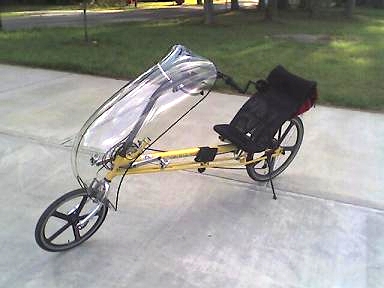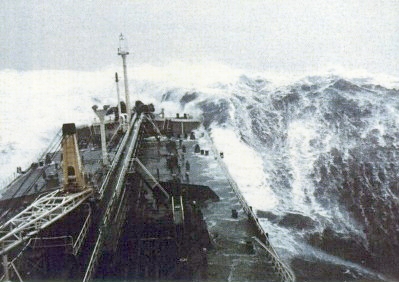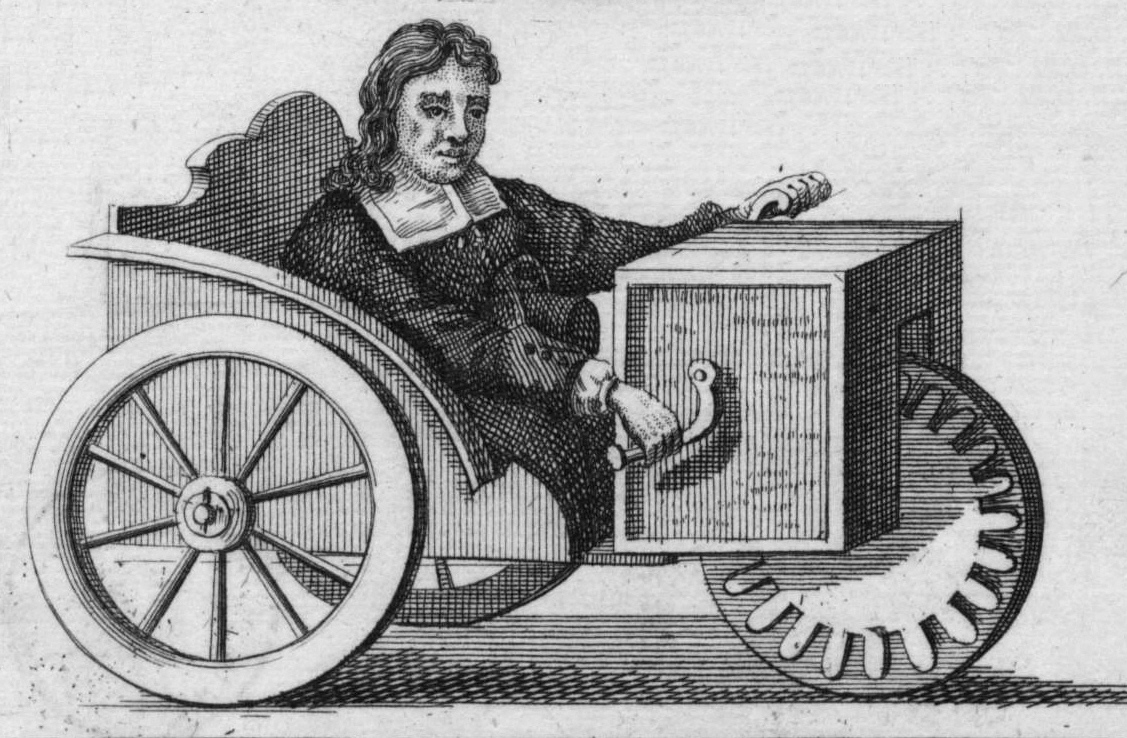|
Whike
Whike is a brand of recumbent tricycles with a sail, manufactured in the Netherlands. First released on 5 June 2008, it has a sail and can reach speeds up to with wind speeds of 4–5 bft (). It can be legally used on both bike lanes and streets in the Netherlands and UK. Activating the front brake releases the sail's spinlock, assuring there will be no more wind-propulsion. Features The Whike features a three piece aluminium mast that can be stowed away on board when not needed. It is also equipped with 18 gears. To maintain responsive stopping the trike is fitted with disc brakes on all wheels. The cycle also has a handbrake. The Whike weighs including the sail and can carry a maximum weight of including luggage. Additionally, the sail can aid visibility of the cycle. Additional features: *Three-wheeled recumbent with sail *Propulsion by wind and Pedal Power *Top speed *Sail operated through pulley and spinlock mainsheet system *Sail released automatically by an ... [...More Info...] [...Related Items...] OR: [Wikipedia] [Google] [Baidu] |
Land Sailing
Land sailing, also known as sand yachting, land yachting or dirtboating, is the act of moving across land in a wheeled vehicle powered by wind through the use of a sail. The term comes from analogy with (water) sailing. Historically, land sailing was used as a mode of transportation or recreation. Since the 1950s, it has evolved primarily into a racing sport. Vehicles used in sailing are known as sail wagons, sand yachts, or land yachts. They typically have three (sometimes four) wheels and function much like a sailboat, except that they are operated from a sitting or lying position and steered by pedals or hand levers. Land sailing works best in windy flat areas, and races often happen on beaches, airfields, and dry lake beds in desert regions. Modern land sailors, generally known as "pilots", can go three to four times faster than the wind speed. A gust of wind is considered more beneficial in a land sailing race than a favorable windshift. A similar sport, known as ice ... [...More Info...] [...Related Items...] OR: [Wikipedia] [Google] [Baidu] |
Recumbent Bicycle
A recumbent bicycle is a bicycle that places the rider in a laid-back reclining position. Most recumbent riders choose this type of design for ergonomic reasons: the rider's weight is distributed comfortably over a larger area, supported by back and buttocks. On a traditional upright bicycle, the body weight rests entirely on a small portion of the Tuberosity of the ischium, sitting bones, the feet, and the hands. Most recumbent models also have an aerodynamics, aerodynamic advantage; the reclined, legs-forward position of the rider's body presents a smaller frontal profile. A recumbent holds the world speed record for a bicycle, and they were banned from racing under the Union Cycliste Internationale (UCI) in 1934, and now race under the banner of the World Human Powered Vehicle Association (WHPVA) and International Human Powered Vehicle Association (IHPVA). Recumbents are available in a wide range of configurations, including: long to short wheelbase; large, small, or a mix ... [...More Info...] [...Related Items...] OR: [Wikipedia] [Google] [Baidu] |
List Of Motorized Trikes
List of motorized trikes is a list of motorized tricycles also called trikes, and sometimes considered cars. There are three typical configurations: motorized bicycle with sidecar; two wheels in the rear, one in the front (aka trike); and two in front, one in the rear (aka reverse trike). However, language and definitions vary. One of the most successful trikes of its day was the De Dion-Bouton tricycle; from 1897 until the start of the 20th century about 15,000 licensed copies were sold, with De Dion Bouton usually supplying the engines, and it was overall the most popular motor vehicle in Europe. Trikes have caused tautological confusion and simply defied typical two and four-wheel classifications, especially in the 21st century. Regardless, many popular motorcycles and/or automobiles had three wheels. Examples 17th century *Stephan Farffler's trike 18th century * Cugnot's ''fardier à vapeur'' (steam powered) 19th century * Ariel 2.25 hp tricycle (1898) * Benz ... [...More Info...] [...Related Items...] OR: [Wikipedia] [Google] [Baidu] |
Sail
A sail is a tensile structure—which is made from fabric or other membrane materials—that uses wind power to propel sailing craft, including sailing ships, sailboats, windsurfers, ice boats, and even sail-powered land vehicles. Sails may be made from a combination of woven materials—including canvas or polyester cloth, laminated membranes or bonded filaments—usually in a three- or four-sided shape. A sail provides propulsive force via a combination of lift and drag, depending on its angle of attack—its angle with respect to the apparent wind. Apparent wind is the air velocity experienced on the moving craft and is the combined effect of the true wind velocity with the velocity of the sailing craft. Angle of attack is often constrained by the sailing craft's orientation to the wind or point of sail. On points of sail where it is possible to align the leading edge of the sail with the apparent wind, the sail may act as an airfoil, generating propulsive force as ai ... [...More Info...] [...Related Items...] OR: [Wikipedia] [Google] [Baidu] |
Beaufort Scale
The Beaufort scale is an empirical measure that relates wind speed to observed conditions at sea or on land. Its full name is the Beaufort wind force scale. History The scale was devised in 1805 by the Irish hydrographer Francis Beaufort (later Rear Admiral), a Royal Navy officer, while serving on . The scale that carries Beaufort's name had a long and complex evolution from the previous work of others (including Daniel Defoe the century before) to when Beaufort was Hydrographer of the Navy in the 1830s, when it was adopted officially and first used during the voyage of HMS ''Beagle'' under Captain Robert FitzRoy, who was later to set up the first Meteorological Office (Met Office) in Britain giving regular weather forecasts. In the 18th century, naval officers made regular weather observations, but there was no standard scale and so they could be very subjective – one man's "stiff breeze" might be another's "soft breeze". Beaufort succeeded in standardising the ... [...More Info...] [...Related Items...] OR: [Wikipedia] [Google] [Baidu] |
Disc Brakes
A disc brake is a type of brake that uses the calipers to squeeze pairs of pads against a disc or a "rotor" to create friction. This action slows the rotation of a shaft, such as a vehicle axle, either to reduce its rotational speed or to hold it stationary. The energy of motion is converted into waste heat which must be dispersed. Hydraulically actuated disc brakes are the most commonly used form of brake for motor vehicles, but the principles of a disc brake are applicable to almost any rotating shaft. The components include the disc, master cylinder, and caliper (which contains a cylinder and two brake pads) on both sides of the disc. Design The development of disc-type brakes began in England in the 1890s. In 1902, the Lanchester Motor Company designed brakes that looked and operated in a similar way to a modern disc-brake system even though the disc was thin and a cable activated the brake pad. Other designs were not practical or widely available in cars for anot ... [...More Info...] [...Related Items...] OR: [Wikipedia] [Google] [Baidu] |
Mainsheet
In sailing, a sheet is a line (rope, cable or chain) used to control the movable corner(s) (clews) of a sail. Terminology In nautical usage the term "sheet" is applied to a line or chain attached to the lower corners of a sail for the purpose of extension or change of direction. The connection in derivation with the root "shoot" is more clearly seen in "sheet-anchor", one that is kept in reserve, to be "shot" in case of emergency. Fore-and-aft rigs Fore-and-aft rigs comprise the vast majority of sailing vessels in use today, including effectively all dinghies and yachts. The sheet on a fore-and-aft sail controls the angle of the sail to the wind, and should be adjusted to keep the sail just filled. Most smaller boats use the Bermuda rig, which has two or three sets of sheets: * The mainsheet is attached to the boom, and is used to control the mainsail. In a rig with no boom on the mainsail, the mainsheet would attach directly to the mainsail clew. A mainsheet is a line con ... [...More Info...] [...Related Items...] OR: [Wikipedia] [Google] [Baidu] |
Outline Of Cycling
:''This article is an outline about the activity of cycling. For an outline about bicycles themselves, see outline of bicycles.'' :The following ''outline'' is provided as an overview of, as well as a topical guide to cycling: Cycling, also called bicycling or biking, is the activity of using / riding bicycles, (at least partially) human-powered, wheeled vehicles (typically by foot pedalling), for purposes including transport, recreation, social interaction, exercise, sport, therapy, other purposes, or any combination thereof. Persons engaged in cycling are called cyclists, bikers, or sometimes bicyclists. They typically either dress for where they are going, or for the cycling, sometimes having another set of clothing with them, or arranged. Apart from regular two-wheeled bicycles, cycling also includes riding unicycles, tricycles, quadricycles, and other similar human-powered wheeled vehicles (HPVs). Some bicycles are sold with (electric) motors (e-bikes), or other ... [...More Info...] [...Related Items...] OR: [Wikipedia] [Google] [Baidu] |
Tricycle
A tricycle, sometimes abbreviated to trike, is a human-powered (or gasoline or electric motor powered or assisted, or gravity powered) three-wheeled vehicle. Some tricycles, such as cycle rickshaws (for passenger transport) and freight trikes, are used for commercial purposes, especially in the developing world, particularly Africa and Asia. In the West, adult-sized tricycles are used primarily for recreation, shopping, and exercise. Tricycles are favoured by children and senior adults for their apparent stability versus a bicycle; however a conventional trike has poor dynamic lateral stability, and the rider must take care when cornering to avoid tipping the trike over. Unconventional designs such as recumbents have a lower centre of gravity so require less care. History A three-wheeled wheelchair was built in 1655 or 1680 by a disabled German man, Stephan Farffler, who wanted to be able to maintain his mobility. A watch-maker, Farffler created a vehicle that was po ... [...More Info...] [...Related Items...] OR: [Wikipedia] [Google] [Baidu] |
Bicycles
A bicycle, also called a pedal cycle, bike or cycle, is a human-powered transport, human-powered or motorized bicycle, motor-powered assisted, bicycle pedal, pedal-driven, single-track vehicle, having two bicycle wheel, wheels attached to a bicycle frame, frame, one behind the other. A is called a cyclist, or bicyclist. Bicycles were introduced in the 19th century in Europe. By the early 21st century, more than 1 billion were in existence. These numbers far exceed the number of cars, both in total and ranked by the number of individual models produced. They are the principal means of transportation in many regions. They also provide a popular form of recreation, and have been adapted for use as children's toys, Physical fitness, general fitness, military and police applications, courier services, bicycle racing, and bicycle stunts. The basic shape and configuration of a typical Safety bicycle, upright or "safety bicycle", has changed little since the first Chain drive, ... [...More Info...] [...Related Items...] OR: [Wikipedia] [Google] [Baidu] |
Tricycles
A tricycle, sometimes abbreviated to trike, is a human-powered (or gasoline or electric motor powered or assisted, or gravity powered) three-wheeled vehicle. Some tricycles, such as cycle rickshaws (for passenger transport) and freight trikes, are used for commercial purposes, especially in the developing world, particularly Africa and Asia. In the West, adult-sized tricycles are used primarily for recreation, shopping, and exercise. Tricycles are favoured by children and senior adults for their apparent stability versus a bicycle; however a conventional trike has poor dynamic lateral stability, and the rider must take care when cornering to avoid tipping the trike over. Unconventional designs such as recumbents have a lower centre of gravity so require less care. History A three-wheeled wheelchair was built in 1655 or 1680 by a disabled German man, Stephan Farffler, who wanted to be able to maintain his mobility. A watch-maker, Farffler created a vehicle that was ... [...More Info...] [...Related Items...] OR: [Wikipedia] [Google] [Baidu] |








.jpeg)


